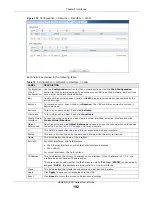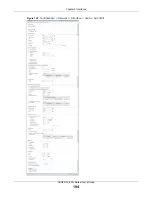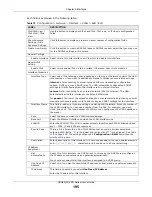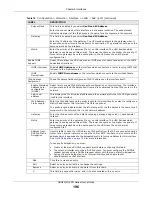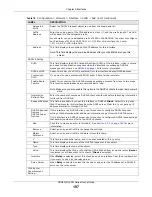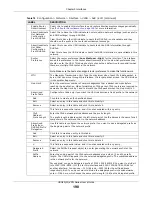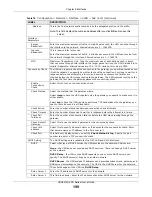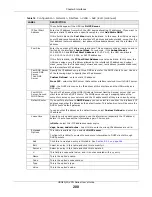
Chapter 9 Interfaces
USG20(W)-VPN Series User’s Guide
203
When the bridge receives a packet, the bridge records the source MAC address and the port on
which it was received in a table. It also looks up the destination MAC address in the table. If the
bridge knows on which port the destination MAC address is located, it sends the packet to that port.
If the destination MAC address is not in the table, the bridge broadcasts the packet on every port
(except the one on which it was received).
In the example above, computer A sends a packet to computer B. Bridge X records the source
address 0A:0A:0A:0A:0A:0A and port 2 in the table. It also looks up 0B:0B:0B:0B:0B:0B in the
table. There is no entry yet, so the bridge broadcasts the packet on ports 1, 3, and 4.
If computer B responds to computer A, bridge X records the source address 0B:0B:0B:0B:0B:0B
and port 4 in the table. It also looks up 0A:0A:0A:0A:0A:0A in the table and sends the packet to
port 2 accordingly.
Bridge Interface Overview
A bridge interface creates a software bridge between the members of the bridge interface. It also
becomes the USG’s interface for the resulting network.
Unlike the device-wide bridge mode in ZyNOS-based USGs, this USG can bridge traffic between
some interfaces while it routes traffic for other interfaces. The bridge interfaces also support more
functions, like interface bandwidth parameters, DHCP settings, and connectivity check. To use the
whole USG as a transparent bridge, add all of the USG’s interfaces to a bridge interface.
A bridge interface may consist of the following members:
• Zero or one VLAN interfaces (and any associated virtual VLAN interfaces)
• Any number of Ethernet interfaces (and any associated virtual Ethernet interfaces)
When you create a bridge interface, the USG removes the members’ entries from the routing table
and adds the bridge interface’s entries to the routing table. For example, this table shows the
routing table before and after you create bridge interface br0 (250.250.250.0/23) between lan1
and vlan1.
Table 77
Example: Bridge Table After Computer A Sends a Packet to Computer B
MAC ADDRESS
PORT
0A:0A:0A:0A:0A:0A
2
Table 78
Example: Bridge Table After Computer B Responds to Computer A
MAC ADDRESS
PORT
0A:0A:0A:0A:0A:0A
2
0B:0B:0B:0B:0B:0B
4
Table 79
Example: Routing Table Before and After Bridge Interface br0 Is Created
IP ADDRESS(ES)
DESTINATION
IP ADDRESS(ES)
DESTINATION
210.210.210.0/24
lan1
221.221.221.0/24
vlan0
210.211.1.0/24
lan1:1
230.230.230.192/26
wan2
221.221.221.0/24
vlan0
241.241.241.241/32
dmz
222.222.222.0/24
vlan1
242.242.242.242/32
dmz
230.230.230.192/26
wan2
250.250.250.0/23
br0
Summary of Contents for ZyWall USG20-VPN
Page 17: ...17 PART I User s Guide ...
Page 18: ...18 ...
Page 99: ...99 PART II Technical Reference ...
Page 100: ...100 ...




